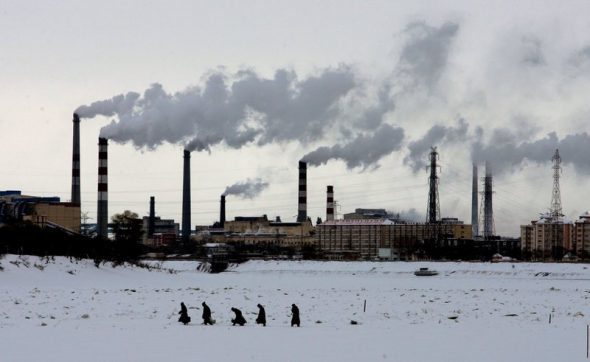Climate Progress

For the third year in a row, global carbon emissions have remained flat, thanks in large part to declining emissions in China.
Carbon emissions from 2016 will only be about 0.2 percent more than in 2015, despite a steady 3 percent growth in the world’s economy, according to a new report from the Global Carbon Project. Before 2014, emissions were increasing at an average rate of 2.3 percent per year.
“This third year of almost no growth in emissions is unprecedented at a time of strong economic growth,” Corinne Le Quéré, Director of the Tyndall Centre at the University of East Anglia, said in a statement. “This is a great help for tackling climate change but it is not enough. Global emissions now need to decrease rapidly, not just stop growing.”
Researchers point to declining coal use in China, the world’s largest emitter of greenhouse gases, as the main driver behind the slowdown in emissions. In 2014, China’s coal use dropped 3 percent. It fell another 5 percent in 2015 — and is on pace this year for another decrease, likely between 2.5 and 3 percent. Regulations to decrease air pollution, a general economic slowdown, and a three-year ban on new coal mines have contributed to the decline of coal use throughout the country.
Overall, China’s emissions fell 0.7 percent in 2015 — a decrease of 77 million tons of CO2 — and are expected to fall another 0.5 percent in 2016.
The United States — the world’s second-largest emitter and largest historic emitter — also saw a 2.6 percent reduction in emissions in 2015, or a decrease of 139 million tons of CO2. That trend that is expected to continue through 2016, with a projected 1.7 percent decrease. U.S. decreases are also due, in large part, to the declining role of coal and the increase in oil and gas in the energy sector. Still, the progress pales in comparison to the reduction targetsset by the Obama administration, which call for a 28 percent reduction in carbon emissions over 2005 levels by 2025.
Other countries did not exhibit the same kinds of emissions reductions seen in the United States and China. In India, the fourth largest emitter in the world, emissions increased 5.2 percent in 2015. In the European Union, the third largest emitter, emissions increased 1.4 percent, despite a period of reductions in years prior.
“Leveling out, like we have over the last three years, is a big surprise.”
And flat-lining emissions have done little to ameliorate the high concentration of carbon dioxide in the atmosphere, which reached record levels earlier this year when it spiked above 400 parts per million, potentially permanently. Carbon dioxide, once released into the atmosphere, is incredibly slow to dissipate — it can remain in the atmosphere for decades, and even centuries, after it is initially released. That means even though emissions have been fairly steady over the last three years, atmospheric carbon dioxide is still influenced by emissions from years ago, when emissions rates were increasing.
It’s difficult to say whether the trends from the last three years portend a turning point for global emissions — Glen Peters, one of the contributors to the research, told the Washington Post that more long-term data from China is necessary before saying for certain whether emissions have peaked.
“But certainly you would say, even leveling out, like we have over the last three years, is a big surprise,” he added. “If you’d stood back three years ago, we wouldn’t have been expecting this. So it’s certainly good news.”
The bad news is that the United States is on the brink of a complete reversal in climate policy under President-Elect Donald Trump, who has called climate change a hoax and pledged to dismantle crucial domestic and international climate policies, such as the Clean Power Plan and the Paris climate agreement. Trump has vowed to bring coal back into the mix, which would likely cause the United States’ share of emissions to rise rather drastically. Coal markets are already anticipating the policies of President Trump — since Trump’s victory on Election Day, stock in Peabody Energy, the bankrupt coal giant, has gone up by more than 47 percent.
Declining emissions in the United States have gone a long way to helping keep the world’s emissions from increasing in the last few years — but under a President Trump, the three years of flat emissions could become a distant memory.










